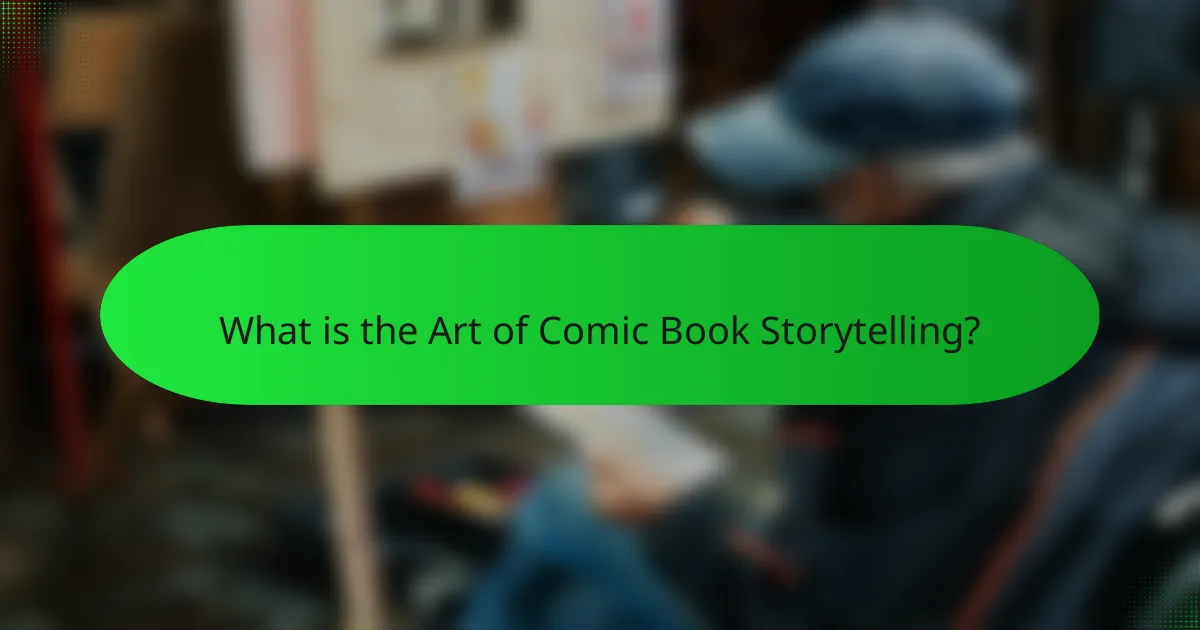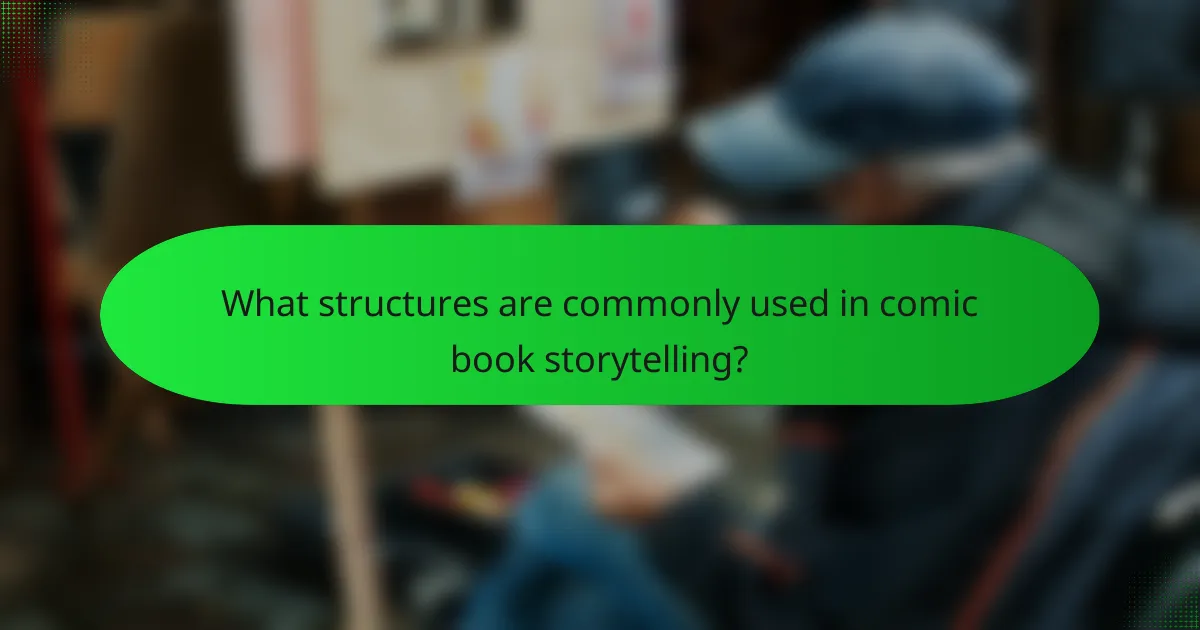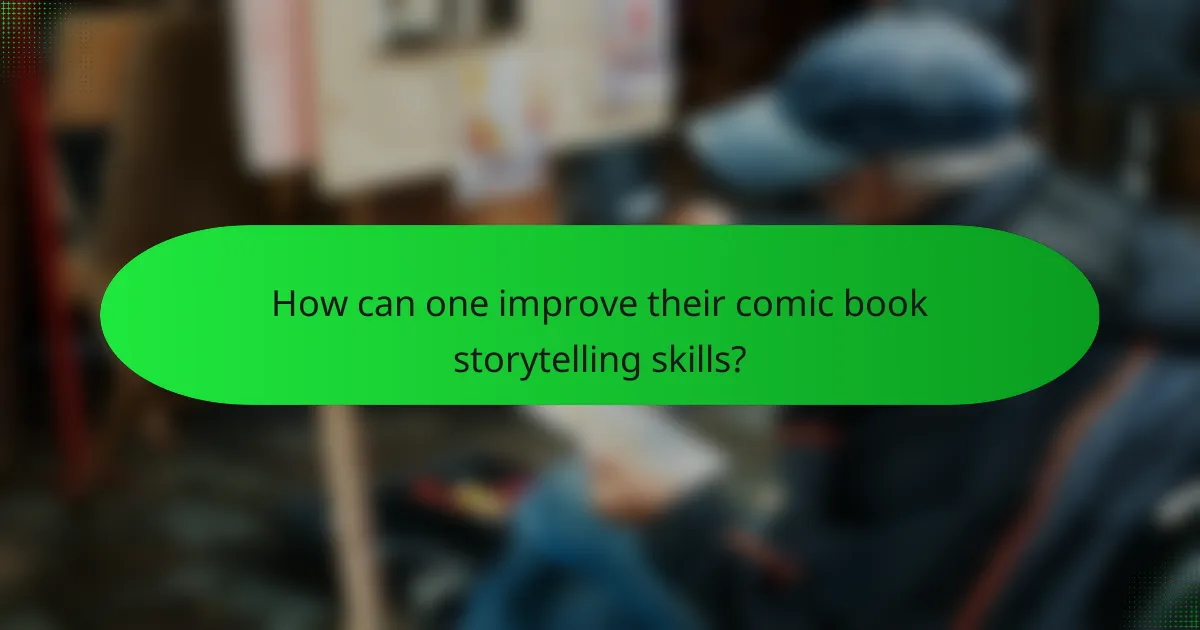The article focuses on comic book storytelling, emphasizing the integration of visual art and narrative to convey engaging stories. Key elements include character development, plot structure, and thematic components, with common storytelling frameworks such as the three-act structure, linear narratives, and non-linear narratives. Techniques for enhancing comic storytelling skills are discussed, including mastering narrative structures, analyzing successful works, and practicing scriptwriting. The article also highlights the importance of visual elements and cultural contexts in shaping effective comic narratives, referencing influential creators like Stan Lee and Jack Kirby.

What is the Art of Comic Book Storytelling?
The art of comic book storytelling involves the integration of visual art and narrative to convey a story. It combines illustrations, dialogue, and pacing to create an engaging experience. Effective storytelling in comics relies on character development, plot structure, and thematic elements. The use of panels guides the reader’s eye and influences the story’s rhythm. Dialogue and captions enhance character voices and emotions. Visual elements, such as color and composition, contribute to mood and tone. Successful comic storytelling often reflects cultural contexts and social issues. Notable examples include works by creators like Stan Lee and Jack Kirby, who shaped the superhero genre.
How does comic book storytelling differ from other narrative forms?
Comic book storytelling differs from other narrative forms through its unique combination of visual art and text. This medium relies on sequential art to convey a story, using panels, speech bubbles, and illustrations. Unlike traditional prose, comic books present information visually, allowing readers to interpret images and words simultaneously. The pacing is controlled by the arrangement of panels, enabling a dynamic flow of narrative. Additionally, comic book storytelling often employs visual metaphors and symbolism that enhance the narrative depth. This format can convey complex emotions and themes quickly, making it distinct from other forms of storytelling. Historical examples, such as “Watchmen” by Alan Moore, showcase how comic books can tackle intricate themes through this blend of art and text.
What unique attributes define comic book storytelling?
Comic book storytelling is defined by its unique combination of visual art and narrative. This medium employs sequential art to convey a story. The use of panels creates a rhythm and pacing that enhances the narrative flow. Dialogue is often presented in speech bubbles, allowing for dynamic character interactions. The interplay of text and imagery creates a layered storytelling experience. Visual symbolism is frequently used to convey themes and emotions. Color palettes can influence mood and tone throughout the narrative. Additionally, comic book storytelling often features a diverse range of genres, from superhero to horror, appealing to various audiences. These attributes set comic book storytelling apart from traditional prose or film narratives.
Why is visual storytelling important in comics?
Visual storytelling is crucial in comics because it conveys narratives through imagery. Comics rely on a combination of illustrations and text to engage readers. The visual elements create emotional connections that words alone may not achieve. For instance, [censured] expressions and body language express characters’ feelings and intentions instantly. This visual medium allows for pacing control, guiding readers through the story’s rhythm. Moreover, studies show that visual information is processed 60,000 times faster than text. This speed enhances comprehension and retention, making the story more impactful. Therefore, visual storytelling is fundamental for effective communication in comics.
What are the fundamental techniques of comic book storytelling?
The fundamental techniques of comic book storytelling include visual composition, pacing, and dialogue. Visual composition involves the arrangement of panels, images, and text to guide reader interpretation. Pacing is crucial for controlling the flow of the narrative, using panel size and layout to manipulate time. Dialogue conveys character voice and advances the plot, often supplemented by visual cues. Additionally, the use of color and art style enhances mood and tone. These techniques work together to create an engaging and cohesive story experience.
How do pacing and panel layout influence storytelling?
Pacing and panel layout significantly influence storytelling in comics. Pacing controls the rhythm of the narrative. It determines how quickly or slowly a story unfolds. Fast pacing can create tension and excitement. Slow pacing allows for reflection and character development.
Panel layout guides the visual flow of the story. It affects how readers perceive time and action. Varied panel sizes can emphasize important moments. A grid layout can create a sense of order and continuity.
Studies show that pacing and layout can evoke different emotional responses. For instance, larger panels may heighten drama. In contrast, smaller panels can convey rapid action. The combination of these elements shapes the reader’s experience.
What role does dialogue play in comic book narratives?
Dialogue serves as a crucial element in comic book narratives. It conveys character emotions, intentions, and relationships. Dialogue enhances storytelling by providing context and advancing the plot. It allows readers to understand character motivations and conflicts. Effective dialogue can create tension and humor within the narrative. The interplay between text and visuals is essential, as dialogue complements the artwork. Historical examples show that iconic comic characters often have distinct speech patterns. This uniqueness contributes to their identity and appeal. Overall, dialogue is integral to engaging readers and enriching the comic book experience.
Why is character development crucial in comic book storytelling?
Character development is crucial in comic book storytelling because it creates emotional connections with readers. Well-developed characters drive the plot and engage the audience. They provide relatable experiences and motivations that resonate with readers. For instance, iconic characters like Spider-Man and Batman have complex backgrounds that shape their actions. This depth allows readers to invest in their journeys. Moreover, character arcs demonstrate growth and transformation, making the story more compelling. Studies show that readers are more likely to follow series with strong character development. This underscores the importance of character in maintaining reader interest and loyalty.
What methods can be used to create compelling characters?
Developing compelling characters involves several methods. First, establish clear backstories for characters. This provides context and depth. Next, create distinct personality traits. Unique traits make characters memorable. Additionally, develop character arcs. Arcs show growth or change, engaging the audience. Use relatable motivations to connect with readers. Characters should have desires that resonate. Incorporating flaws adds realism. Flawed characters are often more relatable. Furthermore, employ dialogue that reflects character voice. Authentic dialogue enhances believability. Lastly, visualize characters through strong visual design. Visuals impact audience perception significantly. These methods collectively enhance character development in storytelling.
How do character arcs enhance the overall story?
Character arcs enhance the overall story by providing depth and complexity to characters. They contribute to emotional engagement, allowing audiences to connect with characters on a personal level. This connection can drive the narrative forward, as characters evolve in response to challenges. A well-developed character arc can create tension and conflict, essential elements in storytelling. Moreover, character arcs often reflect thematic elements, reinforcing the story’s messages. For example, a hero’s journey from doubt to confidence can symbolize personal growth. This transformation can resonate with readers, making the story more impactful. In summary, character arcs are crucial for enriching the narrative and fostering audience investment.

What structures are commonly used in comic book storytelling?
Common structures used in comic book storytelling include the three-act structure, linear narrative, and non-linear narrative. The three-act structure divides the story into setup, confrontation, and resolution. This structure helps build tension and character development throughout the comic. Linear narratives follow a chronological order, making it easier for readers to follow the plot. Non-linear narratives, on the other hand, can create intrigue by presenting events out of sequence. Flashbacks and multiple timelines are often used in non-linear storytelling. These structures enhance reader engagement and allow for creative storytelling techniques.
How do traditional narrative structures apply to comics?
Traditional narrative structures apply to comics by providing a framework for storytelling. Comics utilize elements such as exposition, rising action, climax, falling action, and resolution. These components help create a coherent narrative arc. The sequential art form allows for visual storytelling that complements the written word. Panels represent moments in time, guiding the reader through the story. Dialogue and captions enhance character development and plot progression. Studies show that comics can effectively convey complex narratives using these structures. For instance, Scott McCloud’s “Understanding Comics” emphasizes the importance of narrative flow in comics. This demonstrates how traditional storytelling techniques are integral to comic book storytelling.
What are the common story arcs found in comic books?
Common story arcs found in comic books include the hero’s journey, origin story, and redemption arc. The hero’s journey typically follows a protagonist as they face challenges and grow over time. Origin stories provide background on a character’s motivations and powers. Redemption arcs focus on characters seeking forgiveness or making amends for past mistakes. These arcs are prevalent in popular titles and series, illustrating character development and emotional depth. For example, Spider-Man’s origin story showcases his transformation from an ordinary teenager to a superhero. Similarly, the redemption arc of characters like Magneto highlights complex moral dilemmas.
How can the three-act structure be adapted for comic storytelling?
The three-act structure can be adapted for comic storytelling by aligning visual elements with narrative progression. In the first act, introduce characters and the setting through impactful visuals and concise dialogue. This establishes the premise and hooks the reader. The second act should heighten conflict, using dynamic panel layouts to convey action and tension. This section often includes twists that maintain reader engagement. In the final act, resolve the conflict with a satisfying conclusion, utilizing visual storytelling to emphasize emotional beats. Comics like “Watchmen” and “Maus” effectively demonstrate this structure, showcasing how visuals can enhance narrative depth.
What innovative structures are emerging in modern comics?
Innovative structures in modern comics include non-linear narratives, interactive storytelling, and hybrid formats. Non-linear narratives allow for storytelling that jumps between timelines. This structure engages readers by challenging traditional sequencing. Interactive storytelling incorporates digital elements, enabling reader participation in plot development. Hybrid formats blend comics with other media, such as prose or animation. These innovations reflect evolving reader preferences and technology. They enhance engagement and expand the possibilities of comic book storytelling.
How does non-linear storytelling affect reader engagement?
Non-linear storytelling enhances reader engagement by creating intrigue and encouraging active participation. This storytelling method allows readers to piece together the narrative from various timelines or perspectives. As a result, it fosters curiosity about how different story elements connect. Research indicates that non-linear narratives can increase emotional investment. A study by Oatley (2016) in “The Psychology of Fiction” shows that readers often feel more involved when they must interpret complex story structures. The challenge of understanding non-linear plots can lead to deeper cognitive engagement. Consequently, readers may spend more time analyzing the story, which can enhance their overall experience.
What are examples of experimental formats in comic books?
Examples of experimental formats in comic books include non-linear narratives, unconventional panel layouts, and mixed media approaches. Non-linear narratives disrupt traditional storytelling by presenting events out of chronological order. An example is “Fun Home” by Alison Bechdel, which interweaves past and present. Unconventional panel layouts can create unique reading experiences. “The Sandman” series by Neil Gaiman often utilizes varying panel sizes and shapes to enhance storytelling. Mixed media approaches combine comic art with photography or other art forms. “Clyde Fans” by Seth incorporates elements beyond traditional comics to tell its story. These formats challenge readers’ expectations and expand the boundaries of comic storytelling.

How can one improve their comic book storytelling skills?
To improve comic book storytelling skills, one should focus on understanding narrative structure. Mastering the three-act structure can enhance pacing and character development. Reading widely across genres helps in grasping different storytelling techniques. Analyzing successful comics reveals effective dialogue and visual storytelling methods. Practicing writing scripts strengthens the connection between text and visuals. Joining workshops or critique groups provides valuable feedback and diverse perspectives. Studying character arcs deepens emotional engagement with the audience. Regularly drawing and storyboarding ideas aids in visualizing the narrative flow.
What resources are available for aspiring comic book storytellers?
Aspiring comic book storytellers can access various resources to enhance their skills. Educational books on comic writing and storytelling are widely available. Notable titles include “Understanding Comics” by Scott McCloud and “Making Comics” by the same author. Online courses on platforms like Skillshare and Coursera offer structured learning. Additionally, workshops and seminars often hosted by comic conventions provide hands-on experience. Industry forums and communities such as Comic Book Resources and Reddit’s r/comicbooks allow for peer feedback and networking. Furthermore, creator-owned publishing platforms like Webtoon and Tapas enable storytellers to share their work and gain audience insights.
How can feedback from peers enhance storytelling techniques?
Feedback from peers can significantly enhance storytelling techniques. Peer feedback provides diverse perspectives on narrative clarity and emotional impact. It helps identify plot holes or inconsistencies that the original creator may overlook. Constructive criticism can refine character development, making them more relatable and engaging. Additionally, peers can suggest alternative approaches or techniques that improve pacing and tension. Studies show that collaboration fosters creativity and innovation in storytelling. For example, a 2020 study by the American Psychological Association highlighted that group feedback leads to higher quality creative outputs. Thus, incorporating peer feedback is essential for improving storytelling skills.
What are some best practices for developing characters in comics?
Best practices for developing characters in comics include creating detailed backstories and defining clear motivations. A well-rounded character should have strengths, weaknesses, and distinct personality traits. Visual design plays a crucial role; characters should have unique appearances that reflect their personalities and roles. Dialogue should be authentic and consistent with the character’s voice. Relationships with other characters can add depth and complexity. Additionally, character arcs should show growth or change throughout the story. These practices enhance reader engagement and investment in the characters.
How can character backstories enrich the narrative?
Character backstories enrich the narrative by providing depth and motivation to characters. They help readers understand characters’ actions and decisions. A well-crafted backstory adds layers to character development. It can reveal past traumas or experiences that shape current behavior. For example, a hero’s struggle with loss can create empathy from the audience. This connection encourages investment in the character’s journey. Additionally, backstories can introduce conflicts that drive the plot forward. They can also highlight themes such as redemption or growth. Overall, character backstories are essential for creating a compelling and relatable narrative.
What common pitfalls should be avoided in character development?
Common pitfalls in character development include creating one-dimensional characters. One-dimensional characters lack depth and complexity. They often have predictable motivations and behaviors. This can lead to unengaging narratives. Another pitfall is neglecting character arcs. Characters should evolve throughout the story. A static character can make the plot feel stagnant. Additionally, avoiding stereotypes is crucial. Relying on clichés can diminish originality. Failing to give characters distinct voices can also hinder development. Each character should have a unique perspective and dialogue style. Lastly, not aligning character actions with their motivations can confuse readers. Consistency in character behavior is essential for believability.
What practical tips can enhance comic book storytelling?
To enhance comic book storytelling, focus on strong character development. Characters should have clear motivations and arcs. Engage readers by creating relatable and flawed protagonists. Use visual storytelling to convey emotions and actions effectively. Balance dialogue and imagery to maintain pacing. Incorporate varied panel layouts to create dynamic storytelling. Establish a consistent tone that aligns with the narrative. Lastly, seek feedback from peers to refine your storytelling approach. These strategies are supported by successful comics that prioritize character depth and visual engagement.
How can one effectively balance visuals and text in comics?
Effective balance of visuals and text in comics involves strategic integration of both elements. Visuals should enhance the narrative without overwhelming the text. Text must be concise and placed in a way that complements the artwork. Use speech bubbles for dialogue and captions for narration. This allows readers to process the visuals and text simultaneously. Consider pacing; varying the amount of text can control the flow of the story. Studies show that well-balanced comics improve reader engagement and comprehension. For instance, a 2018 study by the University of Dundee found that comics with harmonious visuals and text enhanced retention of information.
What exercises can help improve storytelling skills in comic creation?
Writing short comic strips can help improve storytelling skills in comic creation. This exercise encourages concise storytelling and character development. It requires focusing on essential plot elements within a limited space. Additionally, creating character backstories enhances understanding of motivations and arcs. This practice deepens narrative complexity. Storyboarding scenes allows for visualizing pacing and transitions. It helps in organizing the flow of the comic. Engaging in peer critiques fosters feedback and diverse perspectives. This interaction can refine storytelling techniques. Lastly, reading various comics exposes different styles and narrative structures. This broadens a creator’s understanding of effective storytelling in comics.
The main entity of this article is comic book storytelling, which integrates visual art and narrative techniques to convey engaging stories. The article covers essential aspects such as the unique attributes of comic storytelling, including character development, pacing, and panel layout. It explores how visual storytelling enhances emotional connections and the importance of dialogue in narrative progression. Additionally, it examines common structures and innovative formats in modern comics, along with practical tips for improving storytelling skills and character development. The content aims to provide a comprehensive understanding of the techniques and frameworks that define effective comic book storytelling.